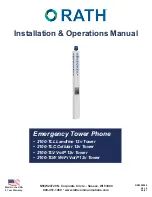
7
1800-065 Issued 1-19
Version D
RF Exposure Information
120 S. Glasgow Avenue
Inglewood, California 90301
U.S.A.
FCC Regulations
This device complies with part 15 of the FCC Rules. Operation is subject to the following two conditions: (1) This device may not cause harmful interference, and
(2) this device must accept any interference received, including interference that may cause undesired operation.
This device has been tested and found to comply with the limits for a Class B digital device, pursuant to Part 15 of the FCC Rules. These limits are designed to
provide reasonable protection against harmful interference in a residential installation. This equipment generates, uses and can radiate radio frequency energy and, if
not installed and used in accordance with the instructions, may cause harmful interference to radio communications. However, there is no guarantee that interference
will not occur in a particular installation. If this equipment does cause harmful interference to radio or television reception, which can be determined by turning the
equipment off and on, the user is encouraged to try to correct the interference by one or more of the following measures:
•
Reorient or relocate the receiving antenna.
•
Increase the separation between the equipment and receiver.
•
Connect the equipment into an outlet on a circuit different from that to which the receiver is connected.
•
Consult the dealer or an experienced radio/TV technician for help.
Changes or modifications not expressly approved by the party responsible for compliance could void the user‘s authority to operate the equipment.
This device meets the government’s requirements for exposure to radio waves.
This device is designed and manufactured not to exceed the emission limits for exposure to radio frequency (RF) energy set by the Federal Communications
Commission of the U.S. Government.
This device complies with FCC radiation exposure limits set forth for an uncontrolled environment.
Glossary for UL 294 Compliance
ACCESS CONTROL SYSTEM:
A collection of means, measures and specific practices that when combined, form or compose a systematic approach, which
enables an authority to control access to areas and resources in a given physical facility. An access control system, within the field of physical security, is
generally seen as the second layer in the security of a physical structure.
ALARM:
A condition indicating a state of alert or tamper detection.
ALARM SIGNAL:
A transmission of an alarm condition or alarm report.
CONTROLLED AREA:
A room, office, building, facility, premises, or grounds to which access is monitored, limited, or controlled.
EQUIPMENT:
Any part of an electronic access control system, such as access control units, reader interface modules, access point actuators, access point
sensors, keypads, and the like.
PROTECTED AREA:
A room, office, building, facility, premise or grounds to which access is monitored, and limited and/or controlled, whereby the authorized
person of the Access Control System may grant access to non-authorized persons.
RESTRICTED AREA:
A room, office, building, facility, premise or grounds to which access is monitored, and limited and strictly controlled, whereby only the
administrator of the Access Control System shall issue credentials that will lead to access.
PERFORMANCE LEVELS:
Destructive Attack:
Level I
Line Security:
Level I
Endurance: Level
IV
Standby Power:
Level I
Single Point Locking Device: Level I

























